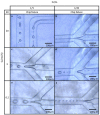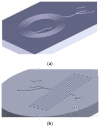Synthesis and Characterization of Hydrogel Droplets Containing Magnetic Nano Particles, in a Microfluidic Flow-Focusing Chip
- PMID: 37367170
- PMCID: PMC10297921
- DOI: 10.3390/gels9060501
Synthesis and Characterization of Hydrogel Droplets Containing Magnetic Nano Particles, in a Microfluidic Flow-Focusing Chip
Abstract
Magnetic hybrid hydrogels have exhibited remarkable efficacy in various areas, particularly in the biomedical sciences, where these inventive substances exhibit intriguing prospects for controlled drug delivery, tissue engineering, magnetic separation, MRI contrast agents, hyperthermia, and thermal ablation. Additionally, droplet-based microfluidic technology enables the fabrication of microgels possessing monodisperse characteristics and controlled morphological shapes. Here, alginate microgels containing citrated magnetic nanoparticles (MNPs) were produced by a microfluidic flow-focusing system. Superparamagnetic magnetite nanoparticles with an average size of 29.1 ± 2.5 nm and saturation magnetization of 66.92 emu/g were synthesized via the co-precipitation method. The hydrodynamic size of MNPs was changed from 142 nm to 826.7 nm after the citrate group's attachment led to an increase in dispersion and the stability of the aqueous phase. A microfluidic flow-focusing chip was designed, and the mold was 3D printed by stereo lithographic technology. Depending on inlet fluid rates, monodisperse and polydisperse microgels in the range of 20-120 μm were produced. Different conditions of droplet generation in the microfluidic device (break-up) were discussed considering the model of rate-of-flow-controlled-breakup (squeezing). Practically, this study indicates guidelines for generating droplets with a predetermined size and polydispersity from liquids with well-defined macroscopic properties, utilizing a microfluidic flow-focusing device (MFFD). Fourier transform infrared spectrometer (FT-IR) results indicated a chemical attachment of citrate groups on MNPs and the existence of MNPs in the hydrogels. Magnetic hydrogel proliferation assay after 72 h showed a better rate of cell growth in comparison to the control group (p = 0.042).
Keywords: alginate; droplet; flow-focusing system; magnetic hydrogel; magnetite; microfluidic systems.
Conflict of interest statement
The authors declare no conflict of interest.
Figures








Similar articles
-
A 3D printed size-tunable flow-focusing droplet microdevice to produce cell-laden hydrogel microspheres.Anal Chim Acta. 2022 Feb 1;1192:339344. doi: 10.1016/j.aca.2021.339344. Epub 2021 Dec 7. Anal Chim Acta. 2022. PMID: 35057943
-
Microfluidic On-Chip Production of Alginate Hydrogels Using Double Coflow Geometry.ACS Omega. 2021 Sep 30;6(40):25964-25971. doi: 10.1021/acsomega.1c02728. eCollection 2021 Oct 12. ACS Omega. 2021. PMID: 34660958 Free PMC article.
-
Microfluidic on-chip production of microgels using combined geometries.Sci Rep. 2021 Jan 15;11(1):1565. doi: 10.1038/s41598-021-81214-7. Sci Rep. 2021. PMID: 33452407 Free PMC article.
-
Emerging Advances in Microfluidic Hydrogel Droplets for Tissue Engineering and STEM Cell Mechanobiology.Gels. 2023 Oct 1;9(10):790. doi: 10.3390/gels9100790. Gels. 2023. PMID: 37888363 Free PMC article. Review.
-
Microfluidics-based fabrication of cell-laden microgels.Biomicrofluidics. 2020 Mar 5;14(2):021501. doi: 10.1063/1.5134060. eCollection 2020 Mar. Biomicrofluidics. 2020. PMID: 32161630 Free PMC article. Review.
Cited by
-
Concave Magnetic-Responsive Hydrogel Discs for Enhanced Bioassays.Biosensors (Basel). 2024 Dec 5;14(12):596. doi: 10.3390/bios14120596. Biosensors (Basel). 2024. PMID: 39727861 Free PMC article.
References
-
- Haider A., Haider S., Kummara M.R., Kamal T., Alghyamah A.A., Iftikhar F.J., Bano B., Khan N., Amjid Afridi M., Soo Han S., et al. Advances in the scaffolds fabrication techniques using biocompatible polymers and their biomedical application: A technical and statistical re-view. J. Saudi Chem. Soc. 2020;24:186–215. doi: 10.1016/j.jscs.2020.01.002. - DOI
-
- Ansar R., Saqib S., Mukhtar A., Niazi M.B.K., Shahid M., Jahan Z., Kakar S.J., Uzair B., Mubashir M., Ullah S., et al. Challenges and recent trends with the development of hydrogel fiber for biomedical applications. Chemosphere. 2022;287:131956. doi: 10.1016/j.chemosphere.2021.131956. - DOI - PubMed
-
- Wang P., Yin K., Duan S., Liu X., Wang Y., Shao D., Alharbi N.S., Alsaedi A., Li J., Wu B., et al. Synthesis and Application of Magnetic Hydrogel for Cr(VI) Removal from Contaminated Water. Environ. Eng. Sci. 2010;27:947–954.
LinkOut - more resources
Full Text Sources

